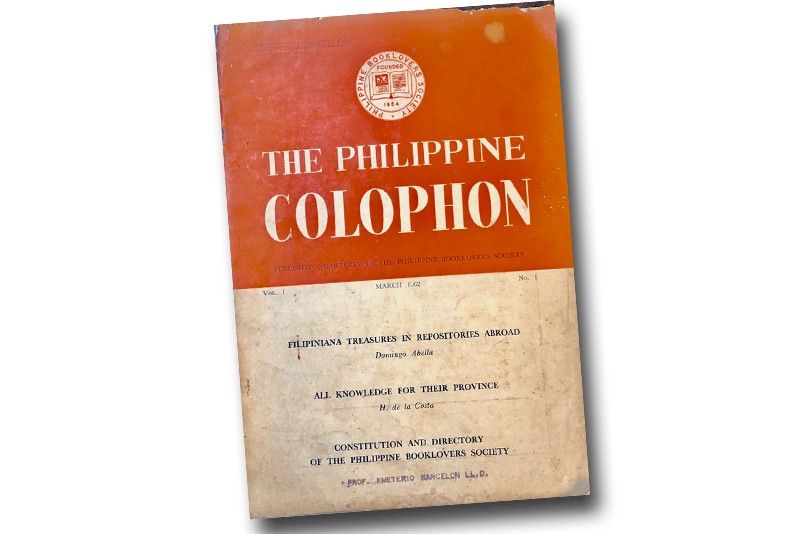Adventures in bookhunting

I had an interesting exchange online recently with a forum member who was responding to my call for old, interesting books that people wanted to sell. I’d explained that by “old,” I meant books from at least the early 1900s, and preferably from the 1800s (my collection includes books and documents from the 1700s, 1600s, and 1500s, but in the Philippine context, 18-something should be old enough).
I got a text from this nice fellow who said that he had a complete set of the first edition of the Encyclopedia Britannica from 1768 to sell to me. I’d specifically stated in my ad that I wasn’t interested in buying encyclopedias, Bibles, and law books. But the message pricked my attention because, as unlikely as finding any book from the 1700s might be in the Philippines, my oldest book — a work in English on the history of institutions, published in London in 1551 and still in very good condition — actually turned up in Cubao. So I wasn’t about to brush off a lead offhand; the strangest things have emerged from local sources in my antiquarian forays.
The seller swore that the set had been in his family for generations, and that it had come down to him from his Lola Filomena. (Names have been changed to protect the innocent.) All right, I thought — that at least was a good sign, the stamp of age. Might the books have been brought to Manila by a British trader in the 1800s (the encyclopedia hadn’t been published yet when they occupied Manila in 1762-’64), then acquired by Lola Filomena’s buena familia forbears? I was thrilled by the possibilities, and asked the seller to send me a picture of the set.
Of course, as soon as it arrived, all my silly hopes were dashed, as I saw a pile of crisp volumes that looked very much like the set I owned back in college. The seller confirmed that the set, indeed, was published in 1970, but that it was truly and surely the original 1768 edition. “Look,” he said with more than a hint of exasperation, “it says Copyright 1768!” I tried to explain the difference between copyright dates and editions (the 15th edition in 2010 was the Britannica’s last printed version). But my textmate wouldn’t budge. “My Lola Filomena wouldn’t lie!” he insisted. I wanted to scream, “But your lola wasn’t alive in 1768!”, but I let it go at that, and thanked him for his time, and for his patience with a curmudgeon.
One of the most frequently asked questions online with regard to old books is “How much is my 1768 Britannica set worth?” Inevitably they show modern editions, not worth very much beyond the priceless knowledge they contain. A facsimile edition came out in 1971 and would itself by now have some value, but let’s face it — a copy’s a copy. Here’s a quick way of being sure that your plastic-covered, 30-volume Britannica set isn’t that old: the 1768 original had only three volumes (oddly broken down into A-B, C-L, and M-Z).
A real find last week — aside from the 1961 first edition of Nick Joaquin’s The Woman Who Had Two Navels — was the maiden (March 1962) issue of The Philippine Colophon, “published quarterly by the Philippine Booklovers Society.” I’d never heard of the PBS before, but its roster of members included such dignitaries as Antonio Abad (the poet Jimmy’s dad), Teodoro Agoncillo, Encarnacion Alzona, Gabriel Bernardo (the UP librarian who helped safeguard leftist documents in the ‘50s), Alberto Florentino, Amado Hernandez, Serafin Lanot (the poet Marra’s dad, and proprietor of Tamaraw Press), Benito Legarda Jr., Charito Planas, and Leopoldo Yabes.
The lead article alone was worth the issue — “Filipiniana Treasures Abroad” by Domingo Abella, a physician-turned-historian who became director of the National Archives. Dr. Abella provides a comprehensive and personally annotated list of foreign libraries — from the US and Mexico to Spain, the UK, Japan, and Macau. He talks about poking around the bookshops in Kanda Street in Tokyo, finding books on the Philippines authored by Western writers.
At a dinner party last weekend, I sat beside a well-known collector who recounted how, back in the day, you could acquire a true first edition of the Noli and Fili and the full 55-volume 1909 edition of Blair and Robertson without hocking the family jewels. “There aren’t too many of us looking for these old books,” he mused. Not few enough, I thought, and indeed, the fewer the better, from the rabid collector’s viewpoint, despite my professed belief in the charitable sharing of knowledge.
Speaking of which, do attend the free public lecture of the renowned bookbinder Mark Cockram at the Ortigas Foundation Library on Thursday, March 15 at 6 p.m. He will also hold a workshop on bookbinding for beginners at the OFL on March 13-14. For details, email ortigasfoundation@ortigas.com.ph.
* * *
Email me at jose@dalisay.ph and visit my blog at www.penmanila.ph.



















